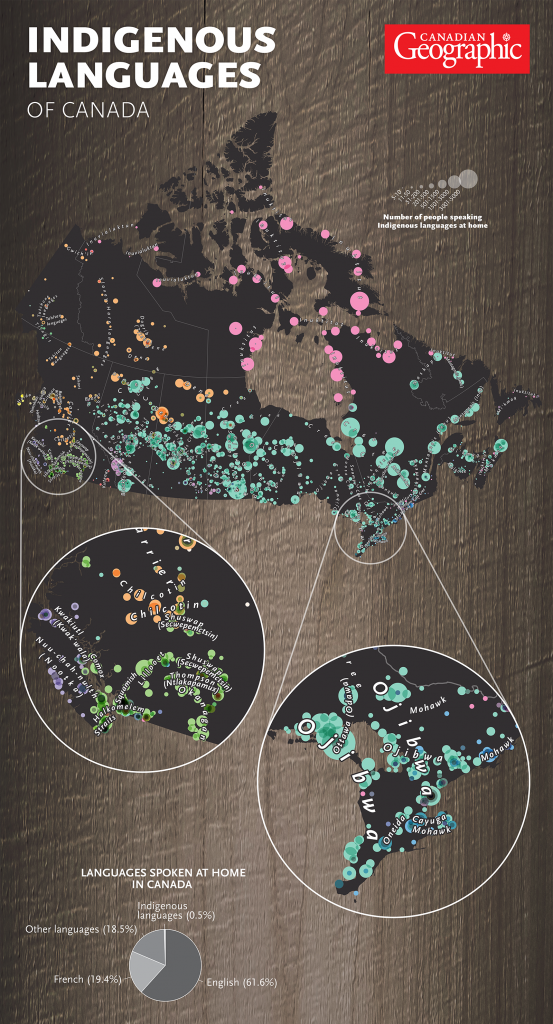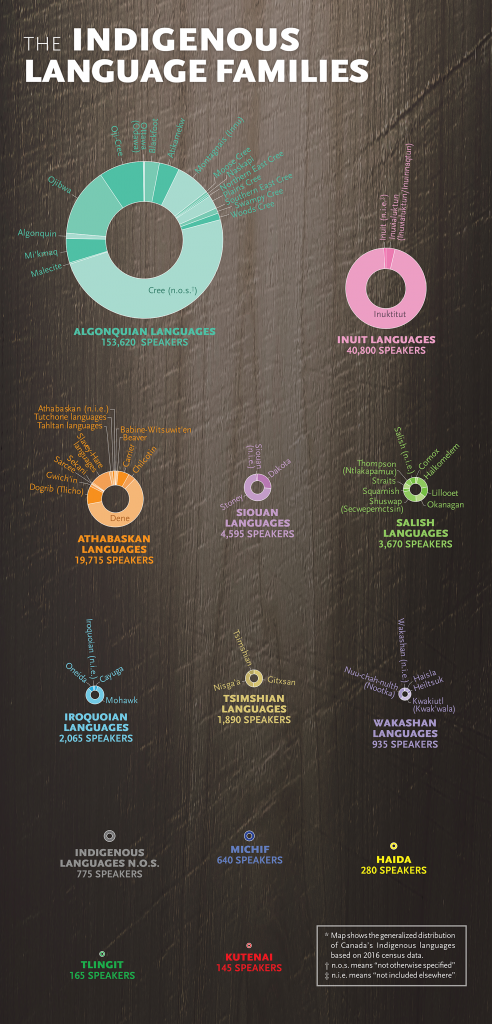16 Languages


Indigenous Languages
Indigenous, Métis, and Inuit languages are often described as “dying” or disappearing, and media headlines tend to focus on how the government or individuals are trying to preserve endangered Indigenous languages. What this narrative overshadows, and indeed attempts to extinguish, is that the story of Indigenous languages is one of resiliency, resistance, and power.
There are over 60 Indigenous languages spoken across Canada, which are categorized into 12 distinct language families (Statistics Canada, 2015). Geographically, Algonquian and Iroquoian are spoken east of Lake Winnipeg; Algonquian, Siouan, and Dene can be found in the Prairies; Dene, Inuit, and Algonquian are spoken in the Subarctic; and Salishan, Tsimshian, Wakashan, Dene, and Algonquian are found in British Columbia (“Indigenous Languages in Canada,” 2016). Cree and Anishinaabemowin/Ojibwe (from the Algonquian family) are the prominent languages in central and eastern Canada (“Indigenous Languages in Canada,” 2016). Inuktitut, spoken by Inuit, is mostly found in the eastern part of the Arctic and in Nunavut (multiple dialects exist in Nunavut) (“Indigenous Languages,” n.d.). Cree is a good illustration of how varied the languages are; it is a single language, and yet up to 10 versions are spoken in different communities (“Indigenous Languages in Canada,” 2016). Algonquian is the largest Indigenous language family in Canada (Statistics Canada, 2015). There are three forms of the Métis language: Michif-Cree, Michif-French, and Ile-a-la-Crosse Michif (“Indigenous Languages,” n.d.).
Suppression of Languages
Indigenous languages have been actively suppressed by the Government of Canada throughout colonization, most predominantly through education (in particular, the residential school system) and government policies like the Indian Act. In its final report, the Truth and Reconciliation Commission (TRC) described how the use of Indigenous languages was restricted in the residential school system and provided a number of individuals’ stories and “memories of being punished for ‘speaking Indian’” (2015, Executive Summary, p. 81). The TRC identifies the broad and deep ways that Indigenous life and culture have been obliterated and erased from Canadian history as a cultural genocide. Many people refer to what happened to Indigenous languages as a linguicide – the intentional suppression of a language in order to destroy a culture (Harp, 2017). This effort to suppress the use of Indigenous languages continues today. “Put simply,” writes Rick Harp (2017), “…our languages literally remind non-Indigenous settlers that we are different, in a way that instantly and unmistakably communicates that we were here first” (original emphasis, para. 7).
Interactive 4.1 John Steckley, Wendat language scholar
John Steckley discusses how he became a scholar of the Huron/Wendat language.
The TRC Calls to Action
The TRC report also includes many stories of Indigenous languages being spoken in secret, demonstrating the resiliency and resistance Indigenous Peoples embodied in order to protect their languages and cultures. Despite their efforts, language loss has been significant and continues to be a critical factor in reconciliation efforts today: “even after [residential schools] were shut down, loss of language knowledge and the fear of speaking Indigenous languages lingered, and therefore inhibited the passing of these languages from one generation to the next” (“Indigenous Languages in Canada,” 2016). The fact that so many Indigenous languages are still spoken across Canada today, after the residential school system and the efforts to enforce English and French, attests to a form of resistance that often goes unrecognized in mainstream understandings of Indigenous history.
In its report, the TRC (2015) emphasized the important connection between culture and language: “language is necessary to define and maintain a world view. For this reason, some First Nation elders to this day will say that knowing or learning the native language is basic to any deep understanding of a First Nation way of life, to being a First Nation person” (Executive Summary, p. 152). In its calls to action, the TRC (2015) called on the “federal government to acknowledge that Aboriginal rights include Aboriginal language rights” (Executive Summary, p. 155).
Current Status
In 2016 Prime Minister Justin Trudeau announced the introduction of the Indigenous Languages Act to help preserve First Nations, Métis, and Inuit languages. This Act created the Aboriginal Languages Initiative (ALI), the only currently existing government program focused on language protection and revitalization. Unfortunately, the ALI has faced criticism from many, including the federal government’s own department of Indigenous and Northern Affairs Canada for being poorly funded and sustained. The prime minister’s announcement was seen as a significant step, but as many critics have pointed out, it comes on the heels of other government-initiated languages programs that have failed as a result of a lack of funding, resources, and consultation (TRC, 2015, Executive Summary, p. 156).
The TRC (2015) has also called upon post-secondary institutions to “create university and college degree and diploma programs in Aboriginal languages” (Executive Summary, p. 157). This call to action recognizes that colleges and universities can play a pivotal role in supporting Indigenous languages and in reconciliation more broadly. To take up that role, they will need to consult with First Nations, Métis, and Inuit communities on how best to promote and celebrate Indigenous languages and self-governance.
Interactive 4.2 Thriving Indigenous Languages by Khelsilem, TEDxWestVancouverED
Khelsilem shares the reasons we need thriving Indigenous languages and how we can make that happen.
References
Harp, R. (2017, February 11). Why it’s misleading to label Indigenous languages as lost or dying. Media Indigena. Retrieved from https://www.mediaindigena.com/misleading-label-indigenous-languages-lost-dying/
Indigenous languages. (n.d.). University of Toronto Libraries. Retrieved from https://guides.library.utoronto.ca/c.php?g=250556&p=1671115
Indigenous languages in Canada. (2016). In The Canadian Encyclopedia. Retrieved from http://www.thecanadianencyclopedia.ca/en/article/aboriginal-people-languages/
Statistics Canada. (2015, December 22). Aboriginal languages in Canada. Retrieved from http://www12.statcan.gc.ca/census-recensement/2011/as-sa/98-314-x/98-314-x2011003_3-eng.cfm
Truth and Reconciliation Commission of Canada. (2015). Honouring the truth, reconciling for the future: Summary of the final report for the Truth and Reconciliation Commission of Canada. Retrieved from http://www.trc.ca/websites/trcinstitution/File/2015/Honouring_the_Truth_Reconciling_for_the_Future_July_23_2015.pdf
Media (in order of appearance)
Brackley, C. [cartographer] (2017). Map of Indigenous languages in Canada [map]. Retrieved from https://www.canadiangeographic.ca/article/mapping-indigenous-languages-canada
Centennial College. (2018). John Steckley, Wendat language scholar [Video file]. Retrieved from https://youtu.be/4d3D9B0ZzZM
[TEDx Talks]. (2017, October 31). Canada Needs Thriving Indigenous Languages | Khelsilem | TEDxWestVancouverED. Retrieved from https://www.youtube.com/watch?v=ljBjUbVWmbQ

